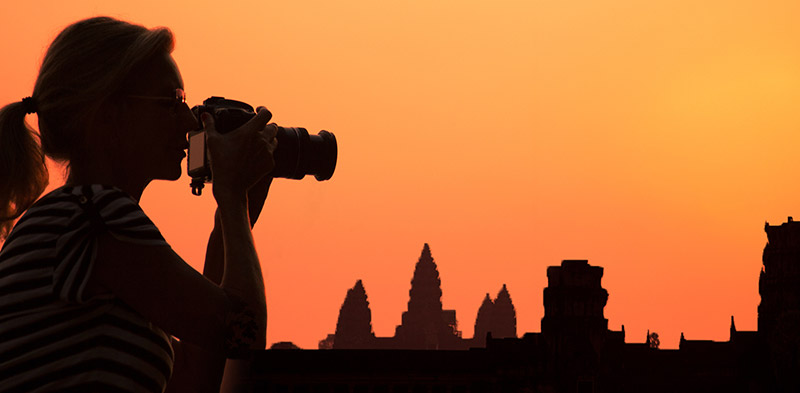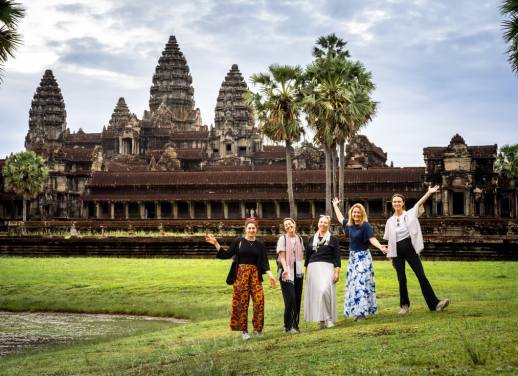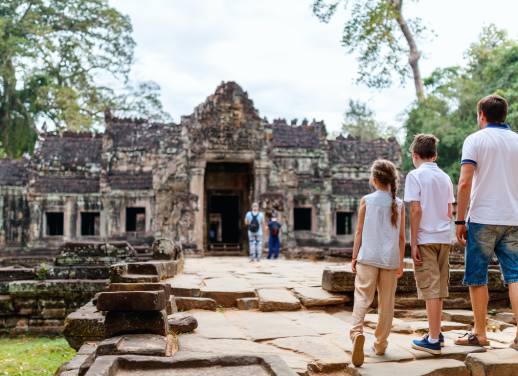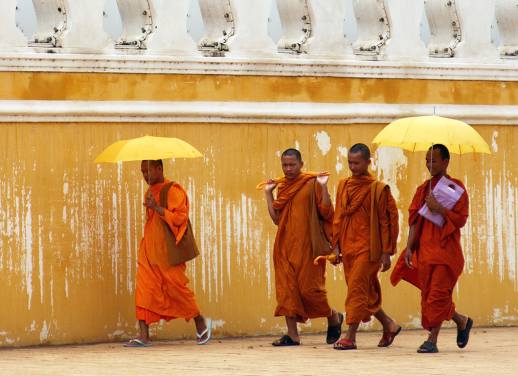One of the best things about moving to Singapore seven years ago was having the opportunity to travel around South East Asia.
My husband and I first visited the Temples of Angkor in 2008 and were immediately hooked. For the intrepid explorer and keen travel photographer, the place is a visual feast. In fact, I had so much fun photographing not only the temples, but also daily life in Cambodia (the markets, the lovely Khmer people and the fascinating floating communities on Ton Le Sap), that I now lead a yearly Photography Tour to Angkor from Singapore with the land arrangements provided by Intrepid Travel.
There are great rewards to be had in Cambodia for the more adventurous travel photographer. People are warm and friendly (having a guide who can translate definitely helps if you’re into travel portrait photography and/or want to learn more from the locals), plus visiting local villages is a fascinating glimpse into times gone by and exploring temples, both forgotten and famous, is so exciting.
Here are a few tips for taking your own great photos of the Temples of Angkor:
1. Take the right gear
Temples: ultra wide angle lens (11-16mm) plus a standard zoom lens (18-70mm)
Indoor markets: fast lens, e.g. 50mm f1.4
Lake communities: super zoom lens with good telephoto ability e.g. 18-200mm
Note: focal length suggestions are for non-professional camera bodies.
2. Approach the temple with the light behind you
Most temples can be approached from different directions (N, W, S, E). Check where the sun is and approach the temple with the sun behind you so that the stones are beautifully lit. Too many shadows can spoil a shot.
3. Take photos right through the day
The smaller, less well-known (but equally interesting) temples are not locked up at night, so begin your exploration at sunrise when you’re likely to be the only person there. (Make sure you buy your temple pass in advance). This makes for some very atmospheric photos, especially if it’s a bit misty and allows you to indulge your Indiana Jones fantasy.
At midday, most tourists head off to lunch so this is a good time to visit the very popular temples if you want to try and avoid the crowds.
At sunset, many of the temples are already covered in shadow by the tall vegetation surrounding them. But, because of its large open space, Angkor Wat is great to photograph at sunset when it’s bathed in warm yellow light. It’s also a beautiful temple to photograph at sunrise if you want to capture a dramatic silhouette with the sun behind.
4. Get creative with Lenses
Try taking a shot from far away with a telephoto lens and then move closer and take a similar shot with a wide angle lens – the effect will be dramatically different.
5. Vary your perspective
Move up, down and around your subject, taking photos as you go. To add something fresh to your photography, try a different angle.
6. Experiment with Depth of Field
For wide angle shots you might want lots of sharpness from the front to the back of the scene so use a narrow aperture like f16. Or, to make your subject stand out against a blurred background and create layers within the frame, zoom in and use a wide aperture like f4.
7. Use People to add a sense of scale
If you want to demonstrate how large something is, include a person in the shot. Be careful – the person should be at the same distance from you (or further) as the object you want to appear huge. If the person is closer to you than the object, the person will appear larger relative to the size of the object.
8. Enhance Colour
If it’s an overcast day and the stone of the temples looks a bit grey and lifeless, change your White Balance setting to Daylight or Cloudy to add a bit of yellow to warm up the stone.
9. Allow lots of time to explore and photograph
You can buy a good-value 3-Day Pass to visit the temples of Angkor. I’d suggest at least 3 days here. If you get temple fatigue, you can always take a break to visit the markets in Siem Reap or the water communities on Ton Le Sap.
10. Be a considerate photographer
Don’t hog the view of a particular scene. If you’re got your shot, move aside so the next visitor can enjoy and photograph it too.
Feature image c/o Karen Lucas, Flickr





